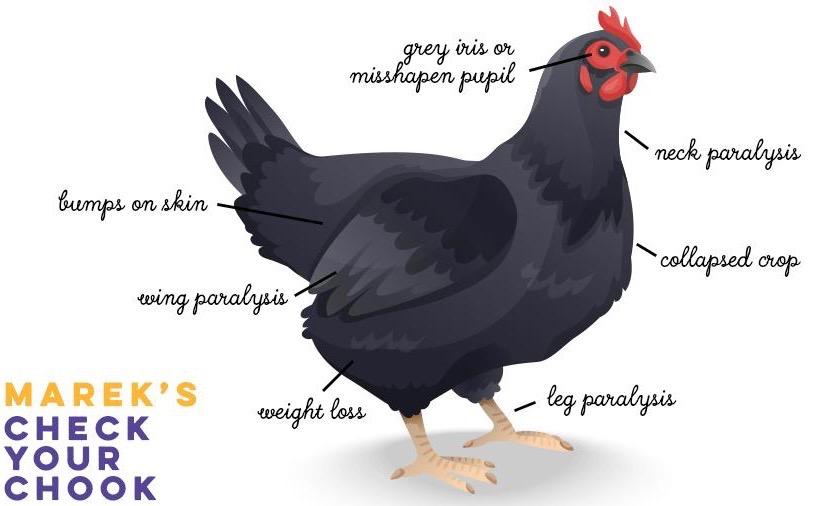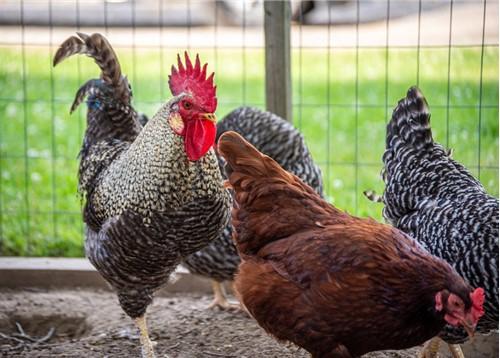Updated: March 31, 2025
Broiler Production Management for Potential and Existing Growers (EB-431)
Broiler production is the largest agricultural revenue generator in Maryland. A broiler is a chicken produced specifically for meat production. Broiler production includes small fryer- to large roaster-type chickens. Approximately 35 percent of cash farm income in Maryland was from broilers in 2016. Maryland ranked eighth nationally in the number of meat chickens produced, and tenth in the number of pounds of meat chickens.
Updated: October 22, 2024
Recognizing and Preventing Marek’s Disease in Small Flocks
Marek’s disease is one of the most widespread poultry diseases in the world. It is a highly contagious viral disease caused by a herpes virus called Alphaherpesvirinae. Marek’s disease occurs in chickens 3–4 weeks of age or older but is most common between 12 and 30 weeks of age. It can also infect quail and, rarely, turkeys. Female birds are infected more often than males. Once the virus is introduced into a chicken flock, infection spreads quickly from bird to bird and infected chickens continue to shed the virus, thus perpetuating a vicious cycle of infection. There is no effective treatment for the disease and infected birds never recover.

Updated: October 22, 2024
Rodent Control on Small Poultry Farms (FS-985)
Mice and rats are nuisance animals that typically can be found anywhere that poultry are grown. These rodents can spread disease and cause structural damage to your facilities, resulting in economic losses. Rodents are known to carry up to 45 different diseases including leptospirosis, Salmonellosis, fowl pox and erysipelas.
Updated: October 21, 2024
Recognizing and Preventing Mycoplasma gallisepticum (MG) Infection in Poultry
Mycoplasma gallisepticum (MG) is a bacteria-like organism that causes respiratory disease primarily in chickens and turkeys but it can also infect gamebirds, pigeons, ducks, geese, peafowl and wild birds. MG infection in chickens is also known as Chronic Respiratory Disease (CRD).
Updated: August 13, 2024
Sickness Behavior in Chickens (FS-1178)
As a prey species, chickens are stoic and typically suppress signs of weakness, including when they are sick. It is difficult to detect sick chickens because they rarely show signs of illness before it becomes severe. Chickens also instinctually hide sickness behavior in the presence of a perceived threat, such as humans, because such behavior tells predators that the ill chicken may be an easy meal (Figure 1; Tizard, 2008). While sickness is mainly associated with pathogenic disease, sickness behavior can also result from injury, nutrient deficiency, and environmental stressors, such as thermal stress. Authors: Ashlyn Snyder, Dr. Jon Moyle, and Dr. Shawna Weimer; Title: Sickness Behavior in Chickens (FS-1178)
Updated: August 12, 2024
Understanding Salmonella; Its Presence and Control in Live Poultry (FS-1137)
The purpose of this extension bulletin is to provide an understanding of what Salmonella is, how it is picked up by birds, and what control strategies can be implemented to reduce its survival and transmission in poultry flocks. Authors: Ashlyn Snyder and Shawna Weimer; Title: Understanding Salmonella; Its Presence and Control in Live Poultry (FS-1137).
 English
English العربية
العربية Български
Български 简体中文
简体中文 繁體中文
繁體中文 Hrvatski
Hrvatski Čeština
Čeština Dansk
Dansk Nederlands
Nederlands Suomi
Suomi Français
Français Deutsch
Deutsch Ελληνικά
Ελληνικά हिन्दी
हिन्दी Italiano
Italiano 日本語
日本語 한국어
한국어 Norsk bokmål
Norsk bokmål Polski
Polski Português
Português Română
Română Русский
Русский Español
Español Svenska
Svenska Català
Català Filipino
Filipino עִבְרִית
עִבְרִית Bahasa Indonesia
Bahasa Indonesia Latviešu valoda
Latviešu valoda Lietuvių kalba
Lietuvių kalba Српски језик
Српски језик Slovenčina
Slovenčina Slovenščina
Slovenščina Українська
Українська Tiếng Việt
Tiếng Việt Shqip
Shqip Eesti
Eesti Galego
Galego Magyar
Magyar Maltese
Maltese ไทย
ไทย Türkçe
Türkçe فارسی
فارسی Afrikaans
Afrikaans Bahasa Melayu
Bahasa Melayu Kiswahili
Kiswahili Gaeilge
Gaeilge Cymraeg
Cymraeg Беларуская мова
Беларуская мова Íslenska
Íslenska Македонски јазик
Македонски јазик יידיש
יידיש Հայերեն
Հայերեն Azərbaycan dili
Azərbaycan dili Euskara
Euskara ქართული
ქართული Kreyol ayisyen
Kreyol ayisyen اردو
اردو বাংলা
বাংলা Bosanski
Bosanski Cebuano
Cebuano Esperanto
Esperanto ગુજરાતી
ગુજરાતી Harshen Hausa
Harshen Hausa Hmong
Hmong Igbo
Igbo Basa Jawa
Basa Jawa ಕನ್ನಡ
ಕನ್ನಡ ភាសាខ្មែរ
ភាសាខ្មែរ ພາສາລາວ
ພາສາລາວ Latin
Latin Te Reo Māori
Te Reo Māori मराठी
मराठी Монгол
Монгол नेपाली
नेपाली ਪੰਜਾਬੀ
ਪੰਜਾਬੀ Afsoomaali
Afsoomaali தமிழ்
தமிழ் తెలుగు
తెలుగు Yorùbá
Yorùbá Zulu
Zulu ဗမာစာ
ဗမာစာ Chichewa
Chichewa Қазақ тілі
Қазақ тілі Malagasy
Malagasy മലയാളം
മലയാളം සිංහල
සිංහල Sesotho
Sesotho Basa Sunda
Basa Sunda Тоҷикӣ
Тоҷикӣ O‘zbekcha
O‘zbekcha አማርኛ
አማርኛ Corsu
Corsu Ōlelo Hawaiʻi
Ōlelo Hawaiʻi كوردی
كوردی Кыргызча
Кыргызча Lëtzebuergesch
Lëtzebuergesch پښتو
پښتو Samoan
Samoan Gàidhlig
Gàidhlig Shona
Shona سنڌي
سنڌي Frysk
Frysk isiXhosa
isiXhosa
